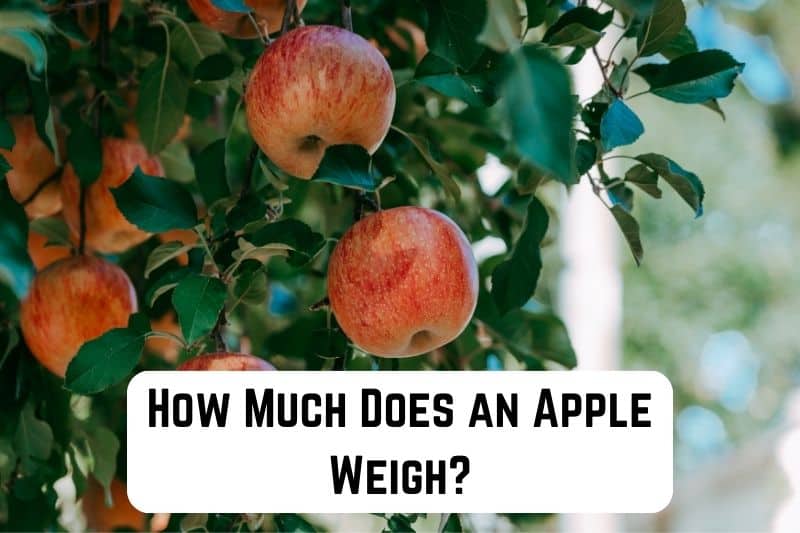Have you ever wondered how much an apple weighs? Curiosity about the weight of apples is common, especially if you’re using them in recipes, monitoring your fruit intake, or simply trying to satisfy an inquisitive side.
It’s important to know that apples come in various sizes and varieties, each with its own unique weight. While an average apple might be around 180 grams (6.35 ounces), there’s certainly a wide spectrum depending on factors such as the fruit’s type, growth conditions, and maturity.
Not to worry, we’ll guide you through this fascinating journey into the world of apple weights. By the time you’re done reading, you’ll have a clearer understanding of the various weights and how they relate to each apple type.
Read: How Much Does a Coconut Weigh? (Detailed Guide)
Generally, an apple weighs between 70 to 100 grams (2.5 to 3.5 ounces), depending on its size and variety. Tiny apples usually weigh approximately 35 to 50 grams (1.25 to 1.75 ounces). Medium-sized apples typically range from 70 to 180 grams (2.5 to 6.3 ounces).
So, let’s delve in and discover how much an apple truly weighs.
How Much Does an Apple Weigh?

You might be curious about the weight of an apple. Well, apples come in various sizes, and their weights vary consequently. Generally, an apple weighs between 70 to 100 grams (2.5 to 3.5 ounces), depending on its size and variety. Let’s look at the common apple varieties and their average weights.
- Small apples (such as crab apples): These tiny apples usually weigh approximately 35 to 50 grams (1.25 to 1.75 ounces). They are mostly used for decoration or making jellies.
- Medium-sized apples (like Fujis, Galas, or Golden Delicious): These apples typically range from 70 to 180 grams (2.5 to 6.3 ounces), making them versatile for snacking and cooking purposes.
- Large apples (such as Granny Smith, Braeburn, or Honeycrisp): These hefty fruits can weigh anywhere from 180 to 300 grams (6.3 to 10.6 ounces). They are popular choices for pies, cobblers, and packed lunches.
Remember, the weight of an apple can also be influenced by factors like weather, growing conditions, and the time they are harvested. For example, apples picked at the beginning of the harvest season might be lighter than those picked later.
Additionally, here’s a simple table for reference:
| Apple Variety | Average Weight (grams) | Average Weight (ounces) |
|---|---|---|
| Small (Crab Apple) | 35-50 | 1.25-1.75 |
| Medium (Fuji, Gala) | 70-180 | 2.5-6.3 |
| Large (Granny Smith) | 180-300 | 6.3-10.6 |
When shopping for apples or preparing a recipe for a certain weight, you can easily use this information to determine how many apples you need. For instance, if a recipe asks for 450 grams (16 ounces) of apples, you’d need around three large apples or six medium-sized ones.
Comparing Various Types of Apples

When you try to determine an apple’s average weight, remember that apples come in various shapes and sizes. For instance, a small apple may weigh about 100 grams, while a large ones can weigh up to 300 grams or more. Here’s a comparison of some common apple types:
- Gala Apple: 133g
- Granny Smith Apple: 174g
- Golden Delicious Apple: 160g
- Fuji Apple: 230g
Factors Influencing Apple Weight

Several factors can influence the weight of an apple. Some of these factors include:
- Environmental conditions: Soil, climate, and weather conditions are crucial in deciding the apple’s size and weight. For example, apples that grow in a suitable climate with proper nutrition in the soil are likely to weigh more than those grown in adverse weather conditions.
- Farming practices: The techniques farmers use to cultivate apples can also determine the weight of the apples. Proper pruning, watering, and care might contribute to larger, heavier fruits.
- Type and variety of the apple: As mentioned earlier, different apple types have different weights on average. Some apples are naturally small, while others are large. The apple variety will play a significant role in determining its weight.
Weight Measurement Process
As you weigh apples, following a simple and accurate process is essential. First, set the scale to zero before placing the apple on it. This will ensure that any additional weight, such as residue on the device, is not factored in.
Once the scale is calibrated, gently place the apple in the center. Give the scale a moment to settle before noting the weight displayed.
If you want to weigh multiple apples, follow a similar process. Make sure the scale is reset to zero after removing the previous apple. Place the next apple on the scale and wait for the weight reading.
Be sure to keep the readings separate to avoid confusion. To make the process easier, using a container can help you weigh more apples simultaneously.
- Step 1: Set the scale to zero.
- Step 2: Place the apple on the scale.
- Step 3: Note the weight displayed.
- Step 4: Repeat the process for multiple apples, resetting the scale each time.
Remember that an apple’s weight can vary depending on its size and type. Small apples can weigh around 100 grams (3.5 ounces), while larger apples can reach 225 grams (8 ounces). Common apple varieties, such as Granny Smith and Honeycrisp, typically weigh around 180 grams (6.4 ounces) each. However, these weights are approximate and can fluctuate.
Real-World Applications of Apple Weight

While you might not have thought about it, knowing the weight of an apple has some pretty interesting real-world applications. So let’s explore a few ways knowing the weight of apples can be helpful!
First, estimating apple weight can be helpful for grocery shopping, especially when following a recipe requiring a certain amount of apples by weight. For instance, if your favorite apple pie recipe calls for 2 pounds of apples, you can roughly estimate how many apples you’ll need to buy.
An average apple weighs about 6 ounces or around 170 grams, so you’d need around five to six apples for your pie.
Next up, apple growers need to monitor the weight of apples to assess crop quality and manage the harvesting process. By keeping track of the average weight of the apples, they can ensure they’re growing healthy and consistent fruit.
Plus, knowing the weight helps estimate the total yield of their orchards, which is crucial for pricing and planning for the market.
Similarly, food manufacturers that produce apple-based products such as juice, cider, or jam need to calculate the amount of raw material required for their production process. If they know the average weight of an apple, they can use it as a basis to predict how much fruit they’ll need to produce a certain quantity of their product.
Lastly, apple-related contests often rely on apple weights to handicap the competition. For example, an apple bobbing or tossing competition may reward contestants based on the combined weight of the apples retrieved or tossed.
These organizers need to know the average weight of an apple to ensure that everyone has an equal chance at success.
Read: How Much Does a Gallon of Propane Weigh? (Propane Weight Chart)
Misconceptions About Apple Weight
You might have heard various claims about the weight of an apple. But let’s clear up some of those misconceptions quickly and easily, with a friendly tone.
First of all, it’s important to recognize that apples come in all sorts of shapes and sizes. There isn’t a one-size-fits-all weight for apples. On average, an apple weighs roughly 150g to 180g (about 5.3oz to 6.3oz). Nonetheless, smaller apples might weigh as little as 70g (2.5oz), and larger ones might tip the scale at over 300g (10.6oz).
There is a popular belief that smaller apples are of lower quality than larger ones. But that’s not necessarily true. While it is accurate that some smaller apples might be less sweet or have a slightly different texture, they are not inherently inferior. In fact, sometimes smaller apples might pack a unique flavor or be perfect for certain recipes.
Another misconception about apple weight is that heavier apples are always juicier. Although it can be true, it isn’t a guarantee. Factors such as moisture content, sugar concentration, and apple variety play a role in the perception of juiciness.
So, next time you’re browsing the produce aisle or picking apples at an orchard, remember that apple weight can vary for numerous reasons. Enjoy your apples, big or small, and focus on their taste rather than the misconceptions surrounding their weight.







